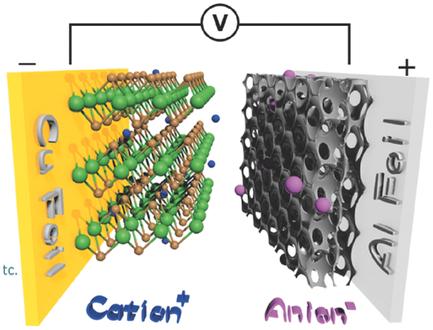当前位置:
X-MOL 学术
›
Adv. Mater.
›
论文详情
Our official English website, www.x-mol.net, welcomes your feedback! (Note: you will need to create a separate account there.)
Nonaqueous Hybrid Lithium‐Ion and Sodium‐Ion Capacitors
Advanced Materials ( IF 29.4 ) Pub Date : 2017-09-22 , DOI: 10.1002/adma.201702093 Huanwen Wang 1, 2 , Changrong Zhu 1 , Dongliang Chao 1 , Qingyu Yan 3 , Hong Jin Fan 1
Advanced Materials ( IF 29.4 ) Pub Date : 2017-09-22 , DOI: 10.1002/adma.201702093 Huanwen Wang 1, 2 , Changrong Zhu 1 , Dongliang Chao 1 , Qingyu Yan 3 , Hong Jin Fan 1
Affiliation

|
Hybrid metal‐ion capacitors (MICs) (M stands for Li or Na) are designed to deliver high energy density, rapid energy delivery, and long lifespan. The devices are composed of a battery anode and a supercapacitor cathode, and thus become a tradeoff between batteries and supercapacitors. In the past two decades, tremendous efforts have been put into the search for suitable electrode materials to overcome the kinetic imbalance between the battery‐type anode and the capacitor‐type cathode. Recently, some transition‐metal compounds have been found to show pseudocapacitive characteristics in a nonaqueous electrolyte, which makes them interesting high‐rate candidates for hybrid MIC anodes. Here, the material design strategies in Li‐ion and Na‐ion capacitors are summarized, with a focus on pseudocapacitive oxide anodes (Nb2O5, MoO3, etc.), which provide a new opportunity to obtain a higher power density of the hybrid devices. The application of Mxene as an anode material of MICs is also discussed. A perspective to the future research of MICs toward practical applications is proposed to close.
中文翻译:

非水混合锂离子和钠离子电容器
混合金属离子电容器(MIC)(M代表Li或Na)旨在提供高能量密度,快速能量输送和长寿命。该器件由电池阳极和超级电容器阴极组成,因此成为电池和超级电容器之间的折衷方案。在过去的二十年中,人们为寻找合适的电极材料付出了巨大的努力,以克服电池型阳极与电容器型阴极之间的动力学失衡。最近,已经发现一些过渡金属化合物在非水电解质中显示出假电容特性,这使它们成为混合MIC阳极的有趣的高速率候选对象。这里总结了锂离子和钠离子电容器的材料设计策略,重点是假电容氧化物阳极(Nb 2O 5,MoO 3等),这为获得混合设备的更高功率密度提供了新的机会。还讨论了将二甲苯用作MICs阳极材料的应用。封闭式集成电路的未来研究前景展望。
更新日期:2017-09-22
中文翻译:

非水混合锂离子和钠离子电容器
混合金属离子电容器(MIC)(M代表Li或Na)旨在提供高能量密度,快速能量输送和长寿命。该器件由电池阳极和超级电容器阴极组成,因此成为电池和超级电容器之间的折衷方案。在过去的二十年中,人们为寻找合适的电极材料付出了巨大的努力,以克服电池型阳极与电容器型阴极之间的动力学失衡。最近,已经发现一些过渡金属化合物在非水电解质中显示出假电容特性,这使它们成为混合MIC阳极的有趣的高速率候选对象。这里总结了锂离子和钠离子电容器的材料设计策略,重点是假电容氧化物阳极(Nb 2O 5,MoO 3等),这为获得混合设备的更高功率密度提供了新的机会。还讨论了将二甲苯用作MICs阳极材料的应用。封闭式集成电路的未来研究前景展望。


























 京公网安备 11010802027423号
京公网安备 11010802027423号